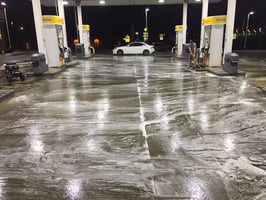Your customers can drive every 2 miles (or even less) to find a gas station. The price of gas from...
What is Soft Washing?
Introduction to Softwashing
Softwashing represents a significant advancement in exterior cleaning technology. Originating as an alternative to traditional pressure washing, softwashing has evolved into a preferred method for safely and effectively cleaning various surfaces. Unlike high-pressure systems, softwashing uses low-pressure equipment combined with specialized cleaning solutions to remove dirt, algae, mold, and other organic stains. This method not only cleans surfaces but also treats them to inhibit future biological growth.
The rise of softwashing can be attributed to its numerous advantages over traditional cleaning methods. It's gentler on surfaces, making it ideal for delicate materials that might be damaged by high-pressure washing. Moreover, the cleaning solutions used in softwashing are designed to target specific stains and organisms, ensuring a thorough clean without the risk of damage.
Understanding the concept of softwashing requires a dive into its history, the science behind it, and its practical applications. This comprehensive guide explores everything from the fundamental principles of softwashing to advanced techniques, ensuring readers gain a thorough understanding of this innovative cleaning method.
Softwashing vs. Pressure Washing
When it comes to exterior cleaning, the debate between softwashing and pressure washing is ongoing. Both methods have their place, but understanding their differences is crucial in determining the best approach for a specific cleaning task.
Key Differences and Applications
- Pressure: Softwashing utilizes a low-pressure system, typically under 100 PSI, whereas pressure washing can exceed 3000 PSI. This fundamental difference in pressure levels makes softwashing more suitable for delicate surfaces like roof shingles, siding, and wood decks.
- Cleaning Solutions: Softwashing relies heavily on cleaning solutions to break down dirt and organic material. These solutions are often biodegradable and tailored to treat specific types of stains and organisms. In contrast, pressure washing primarily uses water force to clean surfaces.
- Longevity: The effects of softwashing tend to last longer. By treating the root cause of stains, such as algae or mold, softwashing prevents quick regrowth. Pressure washing, while effective in removing surface dirt, does
not always address the underlying issues, leading to faster recurrence of stains.
Advantages of Softwashing Over Traditional Methods
Softwashing offers several advantages over pressure washing:
- Gentle on Surfaces: Its low-pressure approach is less likely to cause damage to siding, roof shingles, wood, and other delicate materials.
- Deep Cleaning: The cleaning solutions used in softwashing penetrate and remove organic growths like algae, mold, and mildew more effectively.
- Longer Lasting Results: By addressing the root cause of stains and organic growths, softwashing ensures surfaces stay cleaner for longer periods.
- Eco-Friendly: Many softwashing solutions are biodegradable and less harmful to the environment compared to the high-volume water usage of pressure washing.
- Versatility: Softwashing can be used on a wider range of materials and surface types, including those that cannot withstand high pressure.
Understanding these differences is essential for homeowners and cleaning professionals to choose the most appropriate method for their specific needs.


